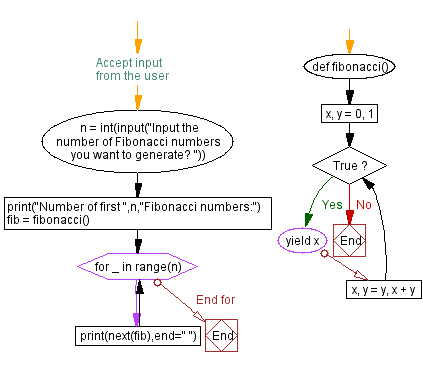Python Fibonacci generator using generators
4. Fibonacci Generator
Write a Python program to implement a generator function that generates the Fibonacci sequence.
In mathematics, the Fibonacci sequence is a sequence in which each number is the sum of the two preceding ones. Numbers that are part of the Fibonacci sequence are known as Fibonacci numbers. Starting from 0 and 1, the first few values in the sequence are: 0, 1, 1, 2, 3, 5, 8, 13, 21, 34, 55, 89, 144.
Sample Solution:
Python Code:
def fibonacci():
x, y = 0, 1
while True:
yield x
x, y = y, x + y
# Accept input from the user
n = int(input("Input the number of Fibonacci numbers you want to generate? "))
print("Number of first ",n,"Fibonacci numbers:")
fib = fibonacci()
for _ in range(n):
print(next(fib),end=" ")
Sample Output:
Input the number of Fibonacci numbers you want to generate? 4 Number of first 4 Fibonacci numbers: 0 1 1 2
Input the number of Fibonacci numbers you want to generate? 10 Number of first 10 Fibonacci numbers: 0 1 1 2 3 5 8 13 21 34
Explanation:
In the above exercise,
- The fibonacci() function is defined as a generator function. It initializes two variables x and y with 0 and 1, respectively.
- The function enters an infinite loop using while True.
- Inside the loop, it uses the yield keyword to yield the current value of x. This represents the Fibonacci number in the sequence.
- After yielding a, the function updates x and y by swapping their values: x becomes y, and y becomes the sum of the previous values of x and y.
- The loop continues, generating the next Fibonacci number each time yield is encountered.
- To use this generator and print the Fibonacci sequence, iterate over it using a loop. Use the next() function to manually retrieve the next Fibonacci number.
Flowchart:

For more Practice: Solve these Related Problems:
- Write a Python generator that yields Fibonacci numbers up to a user-specified count and then prints the resulting sequence.
- Write a Python function to generate Fibonacci numbers using a generator and return the nth Fibonacci number.
- Write a Python script to calculate the sum of the first n Fibonacci numbers by iterating over a Fibonacci generator.
- Write a Python program to yield pairs of consecutive Fibonacci numbers and print each pair.
Go to:
Previous: Python prime number generator using generators.
Next: Python permutations generator using generators.
Python Code Editor:
Contribute your code and comments through Disqus.
What is the difficulty level of this exercise?
Test your Programming skills with w3resource's quiz.
